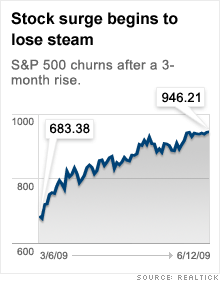Stocks: Back in black, but...
After the biggest rally in years, Wall Street is merely back to where it was at the end of last year. Now what?

NEW YORK (CNNMoney.com) -- Even after staging its best run since the 1970s, the Dow is barely positive for the year -- and all the running to stand still is starting to wear investors out.
"We have a market that appears to be a little nervous," said John Wilson, chief technical strategist at Morgan Keegan. "It still wants to move up, but there's been some disappointment about the rise in rates and drops in mortgage applications."
After a three-month run up, stocks ended little changed last week, although the Dow industrials and the S&P 500 did manage to eke out small gains.
The 10-year note yield hit 4% last week for the first time since October, as investors pulled money out of government debt. That sent mortgage rates up, which could stymie the housing market's path toward stabilization. Add a weak dollar, rising oil and gas prices and trillions of dollars in government stimulus flooding the system -- and worries about inflation are starting to surface.
This week's string of reports include housing starts and building permits, wholesale and consumer inflation, manufacturing and the labor market. Investors will also keep close watch on the bond market.
Most of the economic reports due are expected to show a moderate improvement over the previous reading, a trend in the economic news over the last few months that has helped propel stocks. But a slight improvement in the monthly reports is not to say a recovery is yet taking hold.
"What we've seen recently has reflected an end to the paralysis and panic phase of the cycle in the five or six months since Lehman's collapse," said Joshua Shapiro, chief U.S. economist at Maria Fiorini Ramirez Inc.
"Things aren't as bad as they were, but that period was an aberration in terms of the pace of the slowdown," he said. "We're now back to the grind."
The Dow has now risen in 12 of the last 14 weeks, gaining nearly 33% for its best run since March 1975. The S&P 500's gain in 12 of the last 14 weeks is the best since the 1930s. Even so, the Dow ended Friday's session just barely higher for 2009, while the S&P 500 is up less than 5% year-to-date.
For stocks to move a lot higher, investors are going to need to start to see reports that show a recovery taking hold, not just the pace of a slowdown waning, the analysts said.
Monday: The Empire State index, a measure of manufacturing in the New York area, is expected to have worsened to negative 5.1 in June from negative 4.6 in May, according to a consensus of economists surveyed by Briefing.com. Any reading below zero shows the sector is contracting.
Health care will be in focus Monday. President Obama speaks about reform to the American Medical Association in Chicago. Also the Congressional Budget Office releases its estimates on the Kennedy health bill. The CBO's estimates are key since they are used by Congress in making legislative decisions.
Tuesday: May housing starts and building permits, from the Census Bureau, are both expected to show a slight improvement from earlier levels, as the housing market edges closer to stabilizing.
Housing starts are expected to have risen to a 483,000 unit annual rate in May from a 458,000 unit annual rate in April. Building permits, a measure of builder confidence, is expected to have risen to a 500,000 unit annual rate in May from a 498,000 unit annual rate.
The Producer Price Index (PPI), a measure of wholesale inflation, is expected to have risen 0.6% in June after rising 0.3% in May. The so-called core PPI, which strips out volatile food and energy prices, is expected to have risen 0.1% in June after rising 0.1% in May.
The Federal Reserve releases its reports on industrial production and capacity utilization shortly before the start of trading.
Wednesday: The Consumer Price Index (CPI) for May is expected to fall 0.9% after falling 0.7% in April. So-called core CPI, which strips out volatile food and energy prices, is expected to have risen 0.1% after rising 0.3% in May.
The first-quarter current account balance and the weekly oil inventories report are also on tap.
FedEx (FDX, Fortune 500) reports quarterly results in the morning. The package delivery company, often seen as a proxy for the health of the economy, is expected to have earned 52 cents per share versus $1.45 a year ago.
Thursday: The weekly jobless claims report from the Labor Department is due before the start of trading. The number of Americans filing new claims for unemployment is expected to have risen to 610,000 from 601,000 in the previous week.
The May index of leading economic indicators is due shortly after the start of trading. LEI, from the Conference Board, is expected to have risen 0.9% after rising 1% in the previous month.
The Philadelphia Fed index, a regional read on manufacturing, is expected to have narrowed to a decline of negative 17 in June from a decline of negative 22.6 in May.
Treasury Secretary Timothy Geithner testifies before the House Financial Services Committee about how the Obama administration plans to restructure the financial regulatory system.
Thursday also brings a General Motors bankruptcy hearing in New York.
Friday: State-by-State unemployment reports are due in the morning.
Friday is also a quadruple options expiration day, a quarterly event in which stock index futures and options and individual stock futures and options are all expiring simultaneously. This can create increased volatility in the underlying shares, although the impact has been more measured in recent years. ![]()


